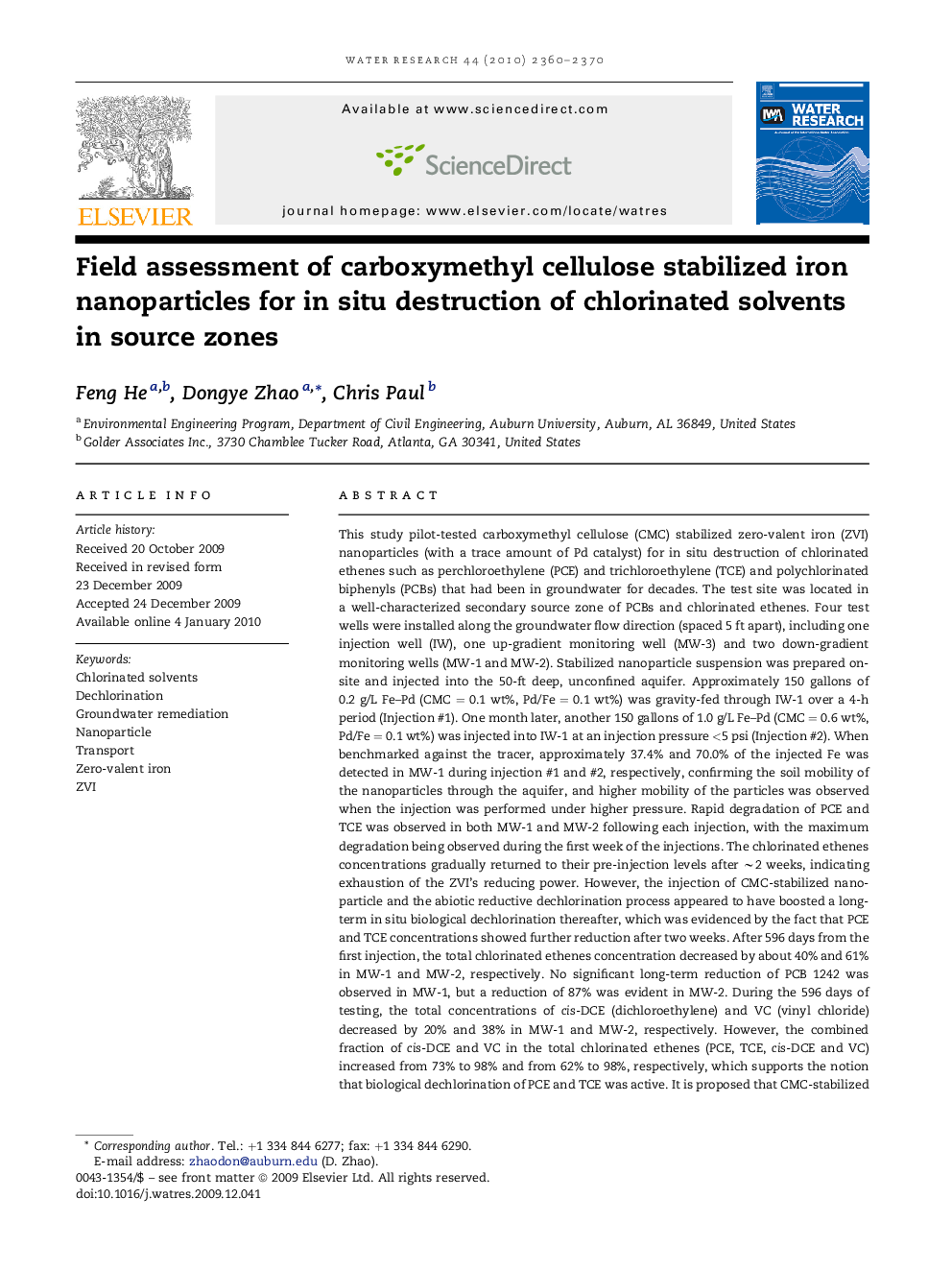| کد مقاله | کد نشریه | سال انتشار | مقاله انگلیسی | نسخه تمام متن |
|---|---|---|---|---|
| 4484046 | 1316907 | 2010 | 11 صفحه PDF | دانلود رایگان |

This study pilot-tested carboxymethyl cellulose (CMC) stabilized zero-valent iron (ZVI) nanoparticles (with a trace amount of Pd catalyst) for in situ destruction of chlorinated ethenes such as perchloroethylene (PCE) and trichloroethylene (TCE) and polychlorinated biphenyls (PCBs) that had been in groundwater for decades. The test site was located in a well-characterized secondary source zone of PCBs and chlorinated ethenes. Four test wells were installed along the groundwater flow direction (spaced 5 ft apart), including one injection well (IW), one up-gradient monitoring well (MW-3) and two down-gradient monitoring wells (MW-1 and MW-2). Stabilized nanoparticle suspension was prepared on-site and injected into the 50-ft deep, unconfined aquifer. Approximately 150 gallons of 0.2 g/L Fe–Pd (CMC = 0.1 wt%, Pd/Fe = 0.1 wt%) was gravity-fed through IW-1 over a 4-h period (Injection #1). One month later, another 150 gallons of 1.0 g/L Fe–Pd (CMC = 0.6 wt%, Pd/Fe = 0.1 wt%) was injected into IW-1 at an injection pressure <5 psi (Injection #2). When benchmarked against the tracer, approximately 37.4% and 70.0% of the injected Fe was detected in MW-1 during injection #1 and #2, respectively, confirming the soil mobility of the nanoparticles through the aquifer, and higher mobility of the particles was observed when the injection was performed under higher pressure. Rapid degradation of PCE and TCE was observed in both MW-1 and MW-2 following each injection, with the maximum degradation being observed during the first week of the injections. The chlorinated ethenes concentrations gradually returned to their pre-injection levels after ∼2 weeks, indicating exhaustion of the ZVI's reducing power. However, the injection of CMC-stabilized nanoparticle and the abiotic reductive dechlorination process appeared to have boosted a long-term in situ biological dechlorination thereafter, which was evidenced by the fact that PCE and TCE concentrations showed further reduction after two weeks. After 596 days from the first injection, the total chlorinated ethenes concentration decreased by about 40% and 61% in MW-1 and MW-2, respectively. No significant long-term reduction of PCB 1242 was observed in MW-1, but a reduction of 87% was evident in MW-2. During the 596 days of testing, the total concentrations of cis-DCE (dichloroethylene) and VC (vinyl chloride) decreased by 20% and 38% in MW-1 and MW-2, respectively. However, the combined fraction of cis-DCE and VC in the total chlorinated ethenes (PCE, TCE, cis-DCE and VC) increased from 73% to 98% and from 62% to 98%, respectively, which supports the notion that biological dechlorination of PCE and TCE was active. It is proposed that CMC-stabilized ZVI-Pd nanoparticles facilitated the early stage rapid abiotic degradation. Over the long run, the existing biological degradation process was boosted with CMC as the carbon source and hydrogen from the abiotic/biotic processes as the electron donor, resulting in the sustained enhanced destruction of the chlorinated organic chlorinated ethenes in the subsurface.
Journal: Water Research - Volume 44, Issue 7, April 2010, Pages 2360–2370